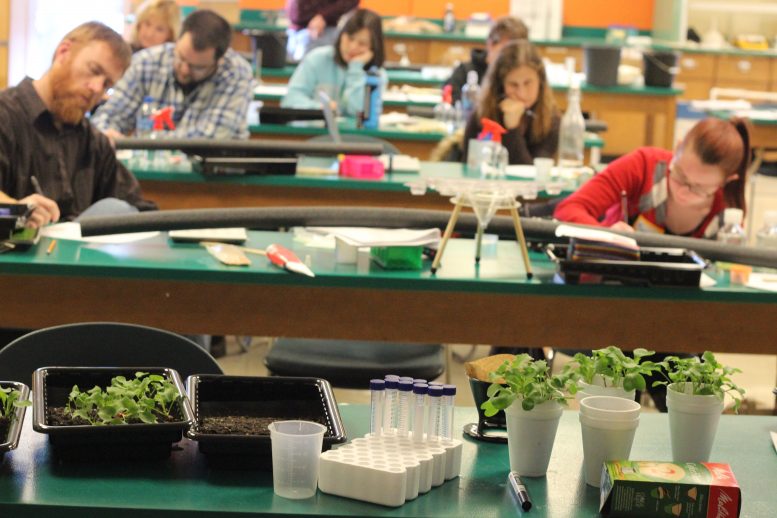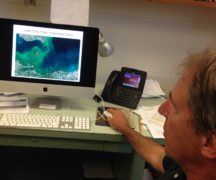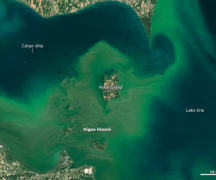By DAVID DUPONT
BG Independent News
Area science teachers visited the Bowling Green State University campus early this month to learn how to integrate lessons ripped from the headlines into their lesson plans.

Karen Krontz,Katey Wendel Allison Hagans, and Doug Reynolds work on an activity.
The professional development sessions brought about a dozen teachers to learn ways to teach intermediate and middle school students about issues surrounding algae blooms in Lake Erie.
Doug Reynolds, who teaches fifth grade at Holland Elementary, said he was excited about having the professional development on “real world problems.”
Like several other teachers in the class this was a return to his alma mater. He earned both his bachelor’s and master’s degrees from BGSU in 1997 and 2000 respectively.
Karen Krontz has yet to earn her BGSU degree. She’s student teaching at Dorr Elementary in Springfield.
“It’s so relatable to everyday life,” she said of the issue. During lessons students share stories about how they use water, and they’re aware of the consequences when something goes wrong. In 2014, toxic blooms made the water in Toledo and much of the surrounding area undrinkable. “They know about algae blooms. Some were affected a few years ago, so they’re very interested.”
The workshop was taught by BGSU professor George Bullerjahn, one of the leading experts on algae blooms, with Mark Seals, director of the School of Teaching and Learning, and STEM educator and researcher Ken Newbury.
The sessions, funded by a $60,000 Ohio Math Science Partnership grant awarded to BGSU, demonstrated simple hands-on activities that showed the dynamics of how algae blooms form and how they can be mitigated.
That meant the teachers getting their hands dirty as they put dirt into trays on top of wire screening. The lesson is intended to show how buffer zones around fields can help keep the runoff rich with nutrients applied as fertilizer from flowing into the lake. Those nutrients nourish the plant life in the lake, just as they nourish plants on land.
Conor Whelan teaches science to fifth and sixth graders at a school for the gifted in Sandusky. Surrounded by farm field, his students are well aware of the concerns.
There are field all around, and run-off comes from those fields.
Whelan quizzed Bullerjahn on what was more of a problem in Lake Erie, farms or municipal runoff.
Bullerjahn said that overflows from sewage plants were the major problem years ago, but as plants have improved. Also more efforts are being made to separate storm water from waste water. Storm water can overwhelm a water treatment plant forcing the release of untreated water.
There are still some problems, he said, but now the flow of nutrients from agriculture represents 80 percent of the input, and much of the attention is focused on reducing that.
The use of cover and roots crops which capture the nutrients, and creating buffer areas that can hold and filter the water are key strategies.
The problem has been exacerbated by more powerful rainfalls that have gotten more frequent in recent years.
Whelan has gotten money from the grant, so that his fifth grade students can go out to the lake and collect their own water samples. “They get excited being out on the water doing something.”
That tangible activity not only makes them more aware of this particular issue, but also piques their interest in science in general.
That’s part of the plan, Seals said. The administrator added he also enjoyed the sessions because it put him back working directly with teachers.
At the end of the day, the teachers were showered with gifts. They got to collect the materials needed to replicate the experiments in their classrooms and other equipment that will help inspire a new generation of scientists and educators.





